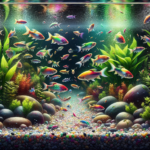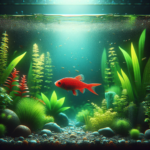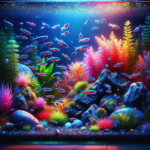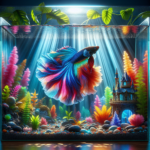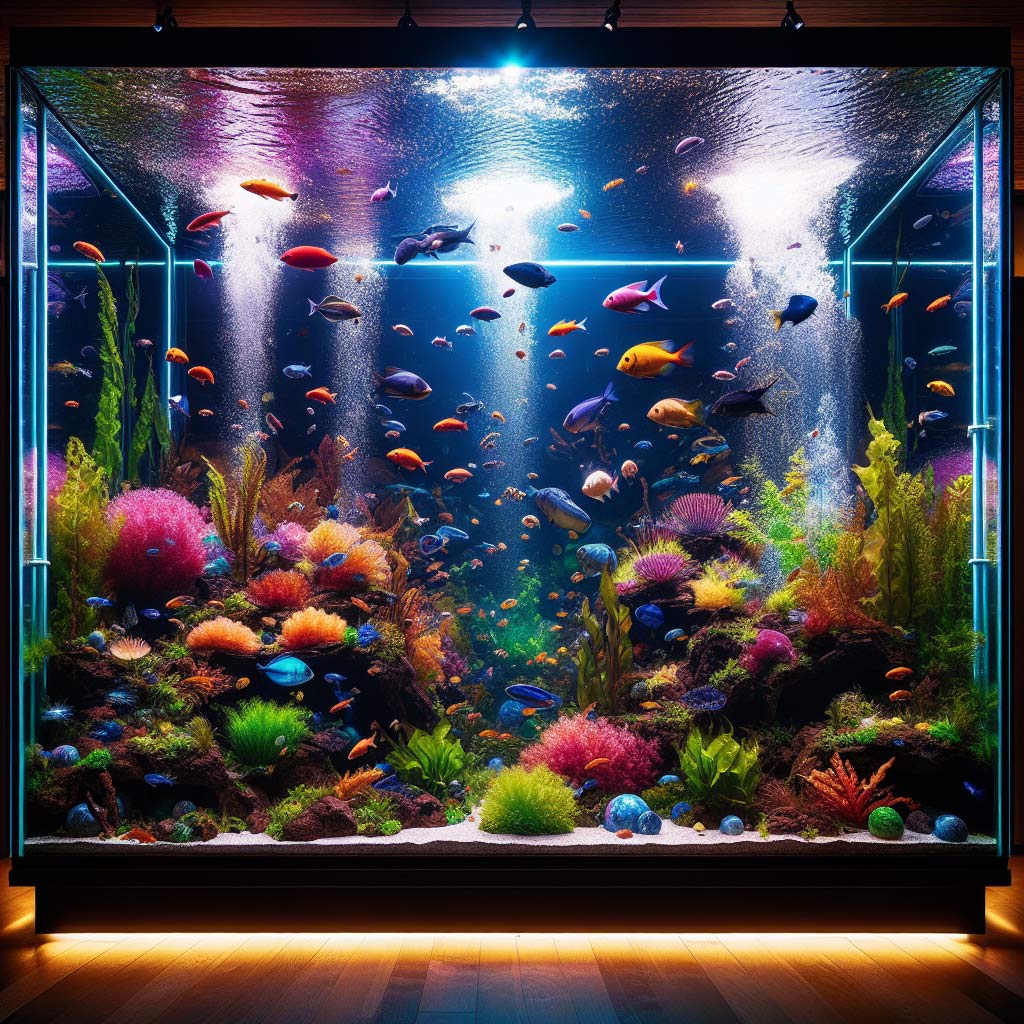
Key Takeaways
- Understand the importance of proper lighting in aquariums for plant growth and fish health.
- Learn the essential components for setting up DIY aquarium lighting.
- Discover how to choose the right LEDs based on color spectrum and intensity.
- Get step-by-step instructions on assembling your DIY lighting system.
- Find out the best practices for mounting, maintenance, and light scheduling.
Benefits of Going DIY with Your Aquarium Lights
When it comes to your underwater habitat, lighting isn’t just for show. It’s a crucial part of the ecosystem that supports plant life and keeps your fish healthy and vibrant. Going the DIY route for aquarium lighting isn’t just a way to save some bucks; it’s about tailoring a system that fits the specific needs of your aquatic family. Plus, it can be a fun and rewarding project!
Basic Components for Crafting Your DIY Aquarium Lighting
Before we dive into the nitty-gritty, let’s talk about what you’ll need for your DIY aquarium lighting project. At its most basic, you’ll need a light source, which is typically LED strips or bulbs due to their efficiency and longevity. You’ll also need a power supply, wiring, and possibly a mounting system depending on your tank setup. Don’t worry; we’ll go through each of these in detail.
Understanding Light Requirements for Different Aquarium Types
Each aquarium has its own unique lighting needs. A freshwater planted tank, for instance, requires a different spectrum of light compared to a saltwater coral tank. Plants and corals rely on light for photosynthesis, which means they need specific wavelengths to thrive. Therefore, it’s essential to tailor your DIY lighting to the type of organisms you’re nurturing.
Choosing the Right LEDs for Your Aquatic Showcase
LEDs are the go-to choice for aquarium lighting, and for good reason. They’re energy-efficient, have a long lifespan, and offer a range of colors and intensities. But with so many options on the market, how do you pick the right ones for your tank?
Selecting the Best Color Spectrum for Plant Growth and Fish Display
The color spectrum of your LEDs is vital. Plants typically need light in the blue and red spectrums to flourish, which is why full-spectrum LEDs are often recommended for planted tanks. For fish display, consider the colors of your fish and decorations to choose LEDs that will make them pop.
Wattage and Lumens: How Much Light Does Your Tank Truly Need?
When it comes to lighting power, more isn’t always better. The wattage and lumens you need depend on your tank size and the light requirements of your plants or corals. A general rule of thumb is to aim for 20 to 40 lumens per liter for a planted freshwater tank. But remember, every tank is different, so adjust accordingly.
Alright, let’s get started on building your DIY aquarium lighting system that will make both your wallet and your underwater friends happy. Stay tuned for the detailed steps in the next sections!
Assembling Your DIY Lighting System
Now, let’s roll up our sleeves and start putting together your DIY lighting system. This is where your creativity and handiness come into play. You’ll be piecing together a system that not only lights up your tank but also brings out the best in its inhabitants.
Gathering Your Materials: What You’ll Need
To kick things off, you’ll need a list of materials. This includes LED strips or bulbs – I recommend waterproof ones for safety. A power supply that matches the voltage and current requirements of your LEDs is a must. Grab some wiring, connectors, and a soldering iron if you’re ready to do some electrical work. Also, think about how you’ll mount your lights – options include brackets, hangers, or adhesives. And don’t forget about tools like wire strippers and screwdrivers.
Remember, you don’t need to break the bank for this project. Many of these items can be found at your local hardware store or online at a reasonable price. It’s all about knowing what you need and where to find it.
Step-by-Step Guide to Building Your Aquarium Light Setup
Building your aquarium light setup is easier than you might think. First, measure your tank to determine the length of LED strips you need. Cut your strips to size, keeping in mind that it’s better to have a bit extra than to come up short. Attach connectors to your strips, and if you’re using a soldering iron, be sure to practice safety precautions.
Next, connect your LED strips to the power supply. Make sure your connections are secure and insulated to prevent any electrical mishaps. If you’re using a mounting system, now’s the time to attach it to your tank. Then, place your LED strips onto the mount, and voilà, you’ve got light!
Integration with Dimmers and Timers for Total Lighting Control
For that extra touch of finesse, consider integrating dimmers and timers into your system. A dimmer allows you to adjust the brightness of your lights to mimic natural daylight cycles, which is great for the well-being of your aquatic plants and animals. Timers automate the lighting schedule, ensuring your tank gets consistent light without you having to lift a finger.
Mounting and Maintenance: Ensuring Long-term Performance
With your lighting system assembled, it’s time to mount it securely. You want to avoid any accidents that could lead to lights falling into the water. Make sure your mounting system is sturdy and can handle the weight of your lights. Once everything is in place, it’s all about maintenance.
Avoiding Common DIY Installation Mistakes
One common mistake is not securing wires and connections properly. Loose wires can lead to shorts and potentially harm your aquarium inhabitants. Another is not considering heat management. LEDs produce heat, so ensure there’s enough ventilation to prevent overheating. Lastly, make sure your system is safe from water splashes to avoid electrical hazards.
Cleaning and Upkeep for Optimum Light Quality
Keeping your DIY lighting system clean is key to maintaining optimum light quality. Dust and water spots can dim your lights and change the color spectrum. Regularly wipe down your lights with a soft cloth, and if you’re using a glass or acrylic shield, clean it to prevent light obstruction.
Lights On: The Finishing Touches
With your lighting system in place, it’s time for the finishing touches. Position your lights to evenly distribute illumination throughout the tank. You might need to adjust the angle or height of your lights for the best coverage. Remember, light needs to reach the bottom for plants and corals to photosynthesize effectively.
Positioning Your Lights for Maximum Effect
Place your lights so they highlight the most attractive features of your tank while providing the necessary light for plant growth. If you have a mixed tank with both plants and fish, find a balance that shows off your fish’s colors while still catering to your plants’ needs.
Tweaking Light Intensity and Duration for Healthier Habitats
Finally, tweak the light intensity and duration to suit your aquarium’s needs. Different species require different amounts of light, so do your research. Most planted tanks will thrive with about 8 to 10 hours of light per day, but watch for signs of distress in your plants and fish, which can indicate that adjustments are needed.
And there you have it – a complete guide to creating a DIY aquarium lighting system that’s both cost-effective and tailored to your aquatic environment. With the right approach and a bit of elbow grease, you’ll have a setup that not only looks professional but also supports the life within your tank.
With your DIY lighting system in place, the health and beauty of your underwater world will be greatly enhanced. But the job isn’t done yet. To ensure your aquatic inhabitants remain healthy and your plants continue to flourish, it’s important to adjust the intensity and duration of your lighting.
Plants in your aquarium rely on light to perform photosynthesis, the process by which they convert light into energy. Without the right amount of light, your plants could suffer, and your fish could miss out on the benefits of a natural environment. This is why tweaking your light settings is so crucial.
For most aquariums, a consistent light schedule of 8 to 10 hours per day is a good starting point. But observe your tank’s response closely. If you notice algae growth, it might mean too much light, while plants that are not thriving could be a sign of too little light. Adjust accordingly, and always aim for a balance that simulates the natural day cycle your fish and plants would experience in the wild.
Tweaking Light Intensity and Duration for Healthier Habitats
To get the light intensity just right, use a dimmer. Start at a lower intensity and gradually increase until you find the sweet spot where your plants are healthy and your fish are active. Duration is equally important. Use a timer to regulate when the lights turn on and off, which helps maintain a regular day/night cycle for your tank inhabitants.
Remember, the goal is to recreate a natural environment that encourages growth and vitality in your aquarium. Keep a close eye on how your ecosystem responds to changes in lighting, and don’t be afraid to make adjustments. Your plants and fish will thank you for it.
Frequently Asked Questions
Now, let’s address some common questions that arise when setting up DIY aquarium lighting. These answers will help you fine-tune your lighting system and ensure its success.
Can DIY Aquarium Lighting Be As Effective As Store-Bought Systems?
Absolutely! With the right materials and a bit of know-how, your DIY aquarium lighting can be just as effective, if not more so, than what you’d buy off the shelf. The key is to understand the specific needs of your tank and to build a system that meets those needs precisely.
How Do I Waterproof My DIY Aquarium Lighting?
Waterproofing is critical for safety and longevity. Use silicone sealant on any openings where water could enter, and opt for waterproof LED strips and covers. Always make sure your electrical connections are far from the water’s reach and use a GFCI outlet to prevent electrical shocks.
What Is the Ideal Light Schedule for a Planted Aquarium?
The ideal light schedule for a planted aquarium typically ranges from 8 to 12 hours per day. This will vary based on the types of plants you have and their light requirements. Use a timer to keep the schedule consistent, which is vital for the health of your plants and fish.
Is LED Lighting Safe for All Types of Fish and Aquatic Plants?
Yes, LED lighting is generally safe for all types of fish and aquatic plants. It’s important, however, to choose the right spectrum and intensity for your specific tank inhabitants. Research your plants and fish to understand their needs and adjust your lighting accordingly.
What Are the Signs My DIY Lights Need Replacing or Repair?
Signs that your DIY lights may need replacing or repair include dimming light output, flickering, and changes in color spectrum. Also, if you notice your plants are not growing as they should or your fish’s behavior has changed, it might be time to check your lighting system.
